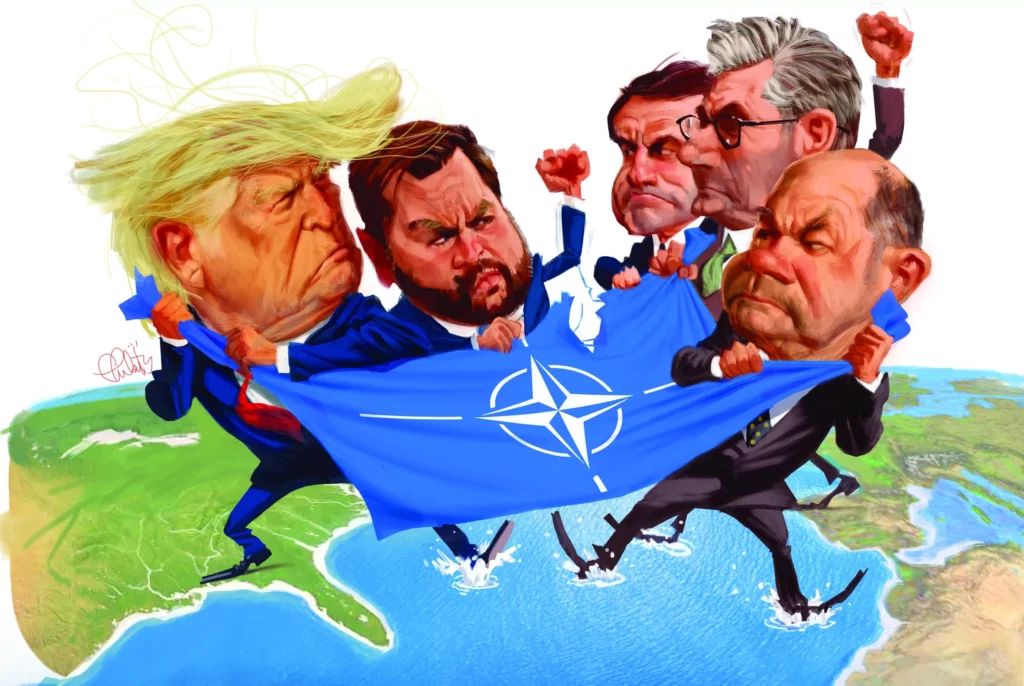
President Donald Trump’s phone call with Russian President Vladimir Putin on Feb. 12 marked the beginning of the end of the three-year war in Ukraine. It also opened a new phase in America’s trans-Atlantic relations. We shall soon discover whether it also means the beginning of the end for NATO and the further destabilization of a Europe unwilling to defend itself, or a rebalancing in which a revitalized Europe buttresses the Trump administration’s global strategy.
It is time, Trump announced on his Truth Social app after talking with Putin, to stop a “ridiculous” war that has caused “massive, and unnecessary, DEATH and DESTRUCTION.” The common response from the leaders of seven European states, including Britain, France, and Germany, seemed more interested in the process than the peace: “Ukraine and Europe must be part of any negotiations.” There must be, Ukrainian President Volodymyr Zelensky added, “no talks about Ukraine without Ukraine.”
Yet when direct negotiations between the United States and Russia began in Saudi Arabia on Feb. 18, the Ukrainians were not invited. Nor were the leaders of the European states there to settle a war they had helped to fund, and which some of them had defined, in British Prime Minister Keir Starmer’s words, as an “existential” struggle for the future of European democracy.

Excluded from the talks, French President Emmanuel Macron cobbled together an emergency meeting in Paris on Feb. 17 with Starmer and German Chancellor Olaf Scholz. Starmer and Macron proposed to commit British and French troops to guarantee Ukraine’s security. Scholz refused. It was, he explained that evening to the press, “highly inappropriate” to hold talks “over Ukraine’s head, over the outcome of peace talks that have not taken place and to which Ukraine has not said yes.”
The United States’s three most powerful European allies disagree with its plan for ending the brutal, destructive stalemate in Ukraine, with Germany the most disagreeable. But they cannot agree among themselves on what to do next, with Germany again the obstacle. The Europeans repeat the Biden administration’s line that the war in Ukraine is a war for democracy, but they neither prosecute the war to their full, albeit limited, capacities nor offer a unified policy for ending it. They do, however, object to the U.S., which has sent more military aid to Ukraine than any other nation, acting to end a war that the Biden administration paid for.
Meeting in Munich
This combination of carping about America, bickering with each other, and grandstanding for the cameras has typified European responses to the Russian invasion of Feb. 24, 2022, and the three years of war that followed. It is the barren fruit of three decades of dependency on American security guarantees. It began in 1991 at the end of the Cold War. It continued, despite ever-louder warnings, until February 2025.
Two days after the Trump-Putin call, Vice President JD Vance gave a scathing address to the Munich Security Conference, the annual meeting of political and military leaders from both sides of the Atlantic. Vance informed Europe’s leaders that the days of unconditional American support were over. The Trump administration, he said, believes that “we can come to a reasonable settlement between Russia and Ukraine.” It also believes that “it’s important in the coming years for Europe to step up in a big way to provide for its own defense.” But the foundation for a common security policy, Vance said, must be the democratic and liberal values that Europe shares with the U.S. Europe’s retreat from those values is, like its skimping on its NATO spending commitments, a betrayal of that alliance.
“For years, we’ve been told that everything we fund and support is in the name of our shared democratic values. Everything from our Ukraine policy to digital censorship is billed as a defense of democracy.” But what kind of values is the U.S. propping up in Europe? Vance listed the evidence: elections overturned in Romania, the European Union’s campaign of internet censorship, the Swedish government’s prosecution of a man who burned a Quran, and prosecutions in Britain for silent prayer within eyesight of an abortion clinic. The real threat to the Atlantic alliance is “not Russia, it’s not China, it’s not any other external actor.” It is “the threat from within, the retreat of Europe from some of its most fundamental values.”
Vance admitted that the retreat of free speech and the advance of censorship in Europe have been encouraged by the U.S. Some of the “loudest” pro-censorship voices have come from America. When the Biden administration “threatened and bullied social media companies to censor so-called misinformation” on the origins of COVID-19, “our own government encouraged private companies to silence people who dared to utter what turned out to be an obvious truth.” Now, however, there is a “new sheriff in town.”
Vance’s speech was a St. Valentine’s Day massacre of the Eurovanities. It will be seen, like President John F. Kennedy’s Ich bin ein Berliner speech, given in Berlin in 1963 as the wall went up, and President Ronald Reagan’s Tear down this wall speech, given in Berlin in 1987 as the Soviet empire ran out of steam, as a watershed in relations between the U.S., Europe, and Russia. It was a blunt recognition of realities. It would never have been given by a Vice President Tim Walz. Finally, the United States is entering the 21st century.
How Russia won
In January, the Biden administration sent its 74th and final tranche of military support, $500 million worth of equipment, to Ukraine. By September 2024, the federal Ukraine Oversight body reported, Congress had made available $183 billion for Ukraine’s defense, of which $86.7 billion had been disbursed. The budgets included $124.9 billion for the Department of Defense, a third of which, $45.7 billion, went to replenishing military stocks. No doubt Elon Musk’s Department of Government Efficiency will be looking at what happened to the $39.8 billion for the U.S. Agency for International Development.
Before 2022, Ukraine was a byword for corruption: a resource-rich klepto-state in the no-man’s land between the EU and Russia. Its banks were connected to the EU’s financial system. Its oligarchs were in Putin’s pocket. Its energy companies were curiously intimate with the family of former President Joe Biden. When the EU wanted to add Ukraine to its quasi-empire, it assumed the Americans would, as they always had, guarantee it by adding Ukraine to NATO. When the Obama administration winked at this, Putin annexed Crimea, with its vital military port on the Black Sea. When Trump warned against further violations, Putin paused. The Biden administration clearly gave Putin the impression that he could chance his arm. When Russia launched a full-scale invasion on Feb. 24, 2022, Biden told the public that this was a “limited incursion.”
What followed was a catastrophic miscalculation for Russia, but one that has achieved several strategic goals. The Ukrainians surprised everyone by fighting off the Russian assault on Kyiv. The Biden administration, prodded by the panicked Europeans, switched from offering Zelensky safe passage to offering military support and managing a military alliance. The goal, a prominent Washington analyst told me in the early weeks of the war, was a proxy war that would “bleed Russia to the last Ukrainian.”
The human cost of deliberately prolonging the war was immense. Ukraine is destroyed. Hundreds of thousands of soldiers have been killed and wounded on both sides. Ukrainian civilians have been slaughtered. There is credible evidence of Russian war crimes. Millions of Ukrainians are refugees. But the battle lines barely shifted after the war’s initial phase. Russia still holds the eastern and southern provinces, most of whose population was heavily Russian before the war. Putin has redrawn the map by force.
The strategic cost to the U.S. is only now becoming clear. The Biden administration used the U.S. dollar and the SWIFT system as weapons of economic warfare. These used to be neutral instruments of the American-built and American-led global order. Their use as instruments of punishment warned America’s rivals what to expect if they got on the wrong side of Washington. This has damaged American credibility and accelerated the “de-dollarization” of the global economy.
Foolishly violating Henry Kissinger’s first principle of Eurasian strategy, the Biden administration pushed Russia into China’s orbit. The policy failed, too. Russia did not collapse as promised. Its economy is now on a war footing and is outproducing the Europeans. The U.S., with an industrial base hollowed by decades of globalization and more pressing challenges in the Middle East and East Asia, cannot make up the shortfall.
Russia’s immediate victory is not on the ground in Ukraine but on the map of Europe. Putin attacked Europe at its weakest point, a state that historically fell within Russia’s sphere of interest but that had not, unlike Poland or the Baltic states, been incorporated into the American sphere of interest. His challenge broke the shallow European consensus by striking at its economic linchpin.
Germany crawling
Germany’s political class was compromised by decades of dealings with Russian energy giants. The German economy was Europe’s biggest, but a fanatical commitment to green energy policies made it dependent on imports of Russian gas. Scholz declared in February 2022 that the Ukraine crisis was Germany’s Zeitenwende, or “turning point,” but the promised security transformation never happened.
The German Council on Foreign Relations reports that Germany became the second-largest donor to Ukraine after the U.S., with the highest level of absolute support in Europe. Relative to GDP, however, the German contribution is smaller than that of 12 other European states. Germany “dragged its feet” on military supplies, too. Scholz has never said that Ukraine should win. He was not happy when someone did what Biden had threatened to do if Russia invaded Ukraine: blow up the Nord Stream 2 pipeline. Germany could never afford the war in Ukraine. It did the minimum to back Zelensky. It will not complicate a peace deal by sending troops now.
While Macron followed the traditional French policy, freelance disruption of les Anglo-Saxons, Britain’s prime minister of the day, Boris Johnson, followed the traditional British policy of echoing the wisdom of the hour from Washington. These policies survived the shuffling of British prime ministers and parties that followed. As in Germany, they did not elicit the massive increase in defense spending that they implied. At the end of the Cold War, Britain spent 7% of its GDP on defense. Today, it is 2.3% — one of the highest among Europe’s NATO members but wholly insufficient after decades of cuts and decay. The Labour government promises to raise that to 2.5% but cannot say when.
Putin has proved the Europeans cannot defend themselves, individually or collectively. When China challenged American leadership, Putin provoked the Biden administration into suggesting that America, the defender of the liberal order, exploits that order in illiberal ways. He used the Biden administration’s strategy of prolonging the war to show that the “arsenal of democracy” cannot restock the arsenals of its fellow democracies. He also showed that while the U.S. was using Ukraine for a proxy war against Russia, America’s NATO allies were using the U.S. as a proxy against Russia for their own agenda.
A farewell to arms
In the early months of the war, the parliaments of the Baltic states (Estonia, Latvia, and Lithuania) endorsed Zelensky’s call for a NATO-enforced no-fly zone over Ukraine. None of the Baltic states’ air forces have an offensive capability. Like many Zelensky initiatives, this was an attempt to draw NATO into a shooting war with Russia. When America’s European allies endorsed this irresponsible and dangerous ploy, they did it knowing that in operational terms, “NATO” means America.
In December 2023, when Zelensky came to Capitol Hill to request more funding, Poland’s new Prime Minister Donald Tusk called “loud and clear for full mobilization on the part of the free world, the West, in support of Ukraine in this war.” There was, Tusk said, “no alternative” to escalation by “the entire Western community.” Again, that means NATO, and NATO means the U.S.
Now that the Trump administration has told Europe to defend itself, only the United Kingdom and France strongly favor guaranteeing Ukraine’s security with European troops. Holland, Denmark, and new-recruit Sweden are inclined to agree. The Baltic republics are on the fence. Italian Prime Minister Giorgia Meloni, who was praised for taking a strong line against Putin, now whispers that troops would be the “most complex and least effective” method of protecting Ukraine. Tusk’s Poland is against it, too. The Europeans warned the U.S. against “appeasement” and “surrender” when they figured that if it came to a fight, the Americans would do the fighting.
The EU’s population is three times larger than Russia’s, and Italy’s GDP alone is larger than Russia’s, but somehow, Europe cannot defend itself. The U.S. bears a degree of responsibility for European fecklessness. NATO’s rationale, its first secretary-general, Hastings Ismay, reportedly said, was to keep the Americans in Europe, keep the Russians out, and keep the Germans down. After 1945, Western Europe’s dependency was as much an American interest as reconstructing its liberal democracies and economies along pliably America-friendly lines.
After 1990, the U.S. opposed European efforts to create a united European military. A Europe with an independent military capacity would become a master of its own fate, not a servant of American policy. The Europeans smirked, nodded, and spent their money on welfare. They exploited this cozy situation and built the EU as a low-risk, high-regulation, low-innovation economy. These policies deferred Europe’s full emergence from its post-1945 rehabilitation. As the petulant reactions to Trump’s Ukraine policy and Vance’s Munich speech show, they institutionalized immaturity and resentment in Europe’s Atlantic-oriented elites.
The EU is now in a double bind. Increasing defense spending means more than a major overhaul of budgetary priorities. The post-1945 European vision assumes that land-grabs and military rivalries are as antiquated and distasteful as a spiked helmet. This attitude speaks of international law and international bodies, but its unacknowledged backstop is American military strength.
Europe’s post-historical fantasies will be the first casualty of its struggle for military autonomy. The next casualties will be the establishment who now sneer at Trump and Vance. To revive a credible military is to admit that official Europe’s domestic enemies — the nationalists, the realists, the reactionaries who believe in nation-states — were right all along. It means cutting welfare budgets, which will accelerate the eclipse of Europe’s post-1990 technocracy by “New Right” nationalists. It means euthanizing Europe as its rulers know it, on orders from its American patron.
CLICK HERE TO READ MORE FROM THE WASHINGTON EXAMINER
Europe’s alternative is to do what it is doing now. Not quite nothing, but not nearly enough. European states now promise to spend more on defense, and most are hitting the NATO target of spending 2% of GDP or close to it. But they have not committed to the higher levels of expenditure that are necessary if they are to rebuild a Cold War level of military capacity and sustain, for instance, regular rotations of brigade-strength forces in Ukraine. It will take years to achieve that. No European leader is willing to talk about how to fund it. This vacuum of seriousness and capacity invites more Russian adventurism.
Even if the Europeans start building their militaries now, Putin has plenty of time to launch further attacks on Europe. An attack on an EU or NATO member could, under this administration, fracture NATO entirely. If that does not happen, it will be because the administration’s plans for a deal on Ukraine include turning Russia from an enemy to an asset. If it does happen, the Europeans will blame Trump but will have only themselves to blame. For nothing is more European, at least in today’s Europe, than being bullied by Russia while complaining about the United States.
Dominic Green is a Washington Examiner columnist and a fellow of the Royal Historical Society. Find him on X @drdominicgreen.






